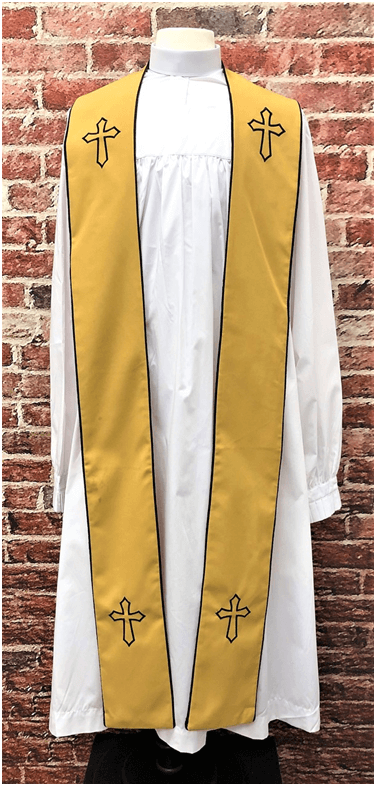A Short History of Clergy Stoles
Jul 10th 2020

Take a quick look through our catalog and there is a chance you will quickly become overwhelmed by the number of unfamiliar terms and selective jargon. We might think it reasonable for you to have some experience with the words “robe” “shirt” or “preaching dress,” but in that mix you are bound to uncover much more, much less conventional terms. Terms for vestments that have backstories as confusing and potentially as unfamiliar as the very names themselves. Names like rochet, alb, surplice, cassock and more are strewn throughout our online store and could definitely use a bit of an introduction, to say the least.
Another of these is the stole, which is a clerical garment that is often worn alongside a number of others and takes the form, in the present day, or an ornamented strip of cloth that an ordained person wears draped over the shoulder and behind the neck. Today, clergy stoles are often taken as a symbol of immortality through the faith, and are often worn by priests administering or officiating the communion. Their origins, though not certain, may offer some insight into their usage in the communion vestments of some modern day priests.
While it can’t be said with particular clarity where clergy stoles originated, the common consensus is that they did not originate as a clerical garment at all, but rather as a lay garment employed by those that could afford them - namely, nobles or patricians of sorts. As they were not designed for use by holy men, they did not carry the significance of today’s modern stoles, and they were also not used the same way.
It is believed that the garment which evolved into clerical stoles, and also into academic stoles, both of which are common enough today, originated in the form of a secular strip of cloth that was worn as an accessory garment. There may be some evidence to suggest that the original scarves or sleeves that became stoles were worn by nobles and used as a handkerchief or a napkin of sorts. This would not have been too extraordinary as nobles would have been the only members of society who could have afforded the expense of extra cloth.
It is also believed that over time as these secular garments became more specialized, some of their owners began to personalize and specialize them with bright dyes and threads, even to include embroidery on some of them.
What is interesting about all of this is the fact that, if it is true, it would largely explain why today’s clerical stoles are often brightly colored, even without paying significant attention to the time of the liturgical year with which they are associated. Also, if the ancestors of today’s stoles were intended to be used as napkins or handkerchiefs, that might explain in some ways why today’s priests wear them as part of communion garb. They are not used in such a capacity today, but may have been at some point in the past.
Following in that vein, we do know that sometime a little over a thousand years ago, priests in the west began adopting a vestment that they absorbed from the traditions of the eastern traditions. This garment was known as an orarium or orarion and it was probably used as a sort of napkin or handkerchief, as we have mentioned. By that point we have the first actual documentations of its use in a clerical capacity, although its image and its usage were probably different from the stoles of present day.
Today, clerical stoles are worn by a number of ordained members of various sects of the church. Anglican, Roman Catholic and even some Protestants wear them, typically in colors matching the other major clerical vestments like the cassock (but not the surplice, if it is worn with a stole).
It’s significance varies, but it often symbolizes immortality, or as mentioned, is worn by the clergyman who officiates the communion. There are also a number of different ways in which modern stoles can be worn, which will vary by the tradition of the church whose members wear it, when they wear it, and for what purpose.
While its origins are somewhat unclear, we do know today how they are used, and we here at Divinity Clergy Wear are proud to offer a wide range of clergy stoles in different colors to suit any time of the year or to match your other vestments. Take a look through our collection of stoles listed above, and if you have any questions on our products, please reach out to us via phone at 1-877-453-3535. We’d love to hear from you even if you just have some more questions on the history of the many vestments we sell. Give us a call any time and we’d be happy to help.